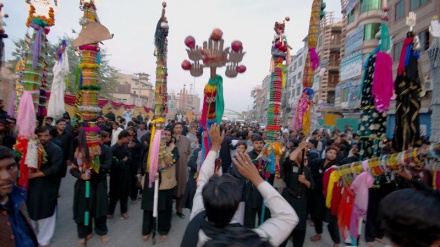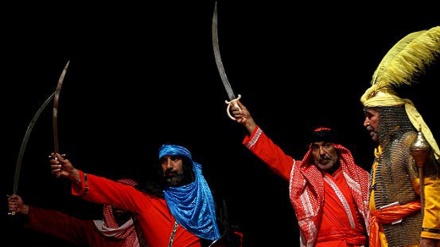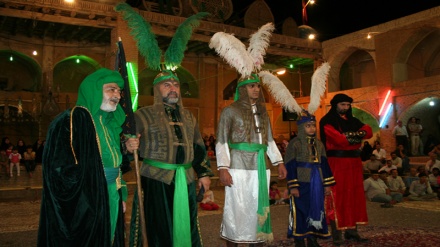Muharram mourning traditions in different lands - 29
Welcome to the 29th part of the 40-plus episodes of a new and interesting series titled “Muharram Mourning Traditions in Different Lands” that we started broadcasting as of October 15 on a daily basis, to commemorate the heartrending tragedy of Karbala, and the martyrdom of Imam Husain (PBUH), the grandson of Prophet Mohammad (Blessings of God upon him and his progeny).
In this series, which delves into the various mourning traditions associated with the Immortal Epic of Ashura in various lands, we look at the history of mourning for Imam Husain (PBUH). Today we talk about the tradition of beating one's chest in Muharram mourning processions. In some parts of Iran particular styles of chest beating have become a tradition over many centuries. We will continue our discussion of different styles of chest beating in various localities in Iran.
In the south western Iranian provinces of Khuzestan and Bushehr there is a long tradition of a certain style of chest beating, known as “uniform chest beating” or “one chest beating”. In uniform chest beating the mourners form concentric circles or rings, and each individual holds on to the waist of the individual standing on his left side , and beats his chest with his right hand. As the mourners beat their chest, the concentric circles (rings) of mourners slowly rotate. The mournful elegies accompanying this type of chest beating are usually heavy and slow, known locally as Bushehr-type elegies. Uniform chest beating usually follows mourning ceremonies using cymbals and drums (Marasem-e Senj va Dammam in Persian). At first the reciter of the elegies, starts his recitation. A crowd of mourners will then gradually gather round and circles and rings of mourners begin to take shape. After much chest-beating and the singing of 5 or 6 elegies, the reciter stops for a number of seconds, and then shouts “uniformity” or “Oneness”. Upon his “order” we reach the culmination of the mourning ceremonies, and the mourners change their rhythm of chest beating, often this rhythm reduces to a half.
In Bushehr province in southwestern Iran, there is another long-established local mourning ceremony in the month of Muharram, known as “Yezleh”. Usually, the “Yezleh” ceremony comes after the chest beating ceremony. “Yezleh” ceremony is as follows: A human chain is formed when each mourner holds on to the waist of the person in front of them, and according to the rhythm of the “Yezleh” elegy or poem, the human chain slowly and rhythmically, step-by-step, moves forward. When the group has travelled some distance, it stops, and then the human chain transforms into a (human) circle, and the mourners, in tune with the rhythm of Yezleh elegy, start beating their chests, bowed, and move towards the center of the circle. Different elegies, lamentations and poems are recited during the “Yezleh” ceremony, depending on which day of the month of Muharram it is. For example, in the night of “Tasua”, 9th of Muharram, the mourners chant: “Tonight is Tasua, Tonight is mayhem in Karbala”!!
Arguably, the most famous chest-beating ceremony in Iran is held every Muharram in the city of Zanjan in northwestern Iran. In the afternoon of the 8th of Muharram every year, a massive and extraordinary mourning procession takes place in the city of Zanjan. People not just from Zanjan but from adjacent Azeri-speaking provinces of Ardebil, Azerbaijan and Qazvin, attend the mourning procession in Zanjan. Several thousand sheep and lamb are sacrificed on that day, and in fact many of those sheep are offerings from other regions of Iran which are brought to Zanjan!! Traditional elegies and lamentations, as well as chest beating, are all part of the massive mourning procession which throngs the streets of Zanjan, throughout the first ten days of Muharram, but particularly on the 8th, 9th and 10th of that month.
In the city of Shiraz in southern Iran, another local style of chest beating, known as “spiral (or labyrinthine) chest beating” can be seen every Muharram. This mourning ceremony takes place in several mosques in Shiraz during Muharram. In this ceremony mourners stand neatly in rows, then take two steps forward, they beat their chests, and cry out loudly Husain, Husain!! The chest beating and lamentation continues until those at the beginning of the spiral reach those who were originally at the end of the spiral. When this happens the ceremony ends.
MD/AS/ME


